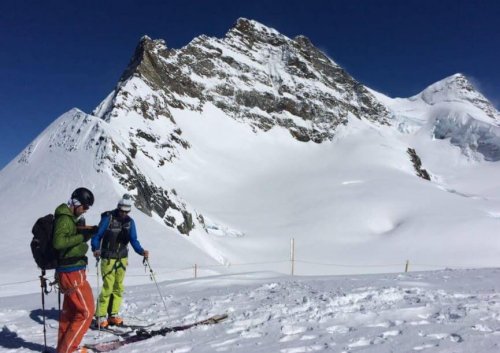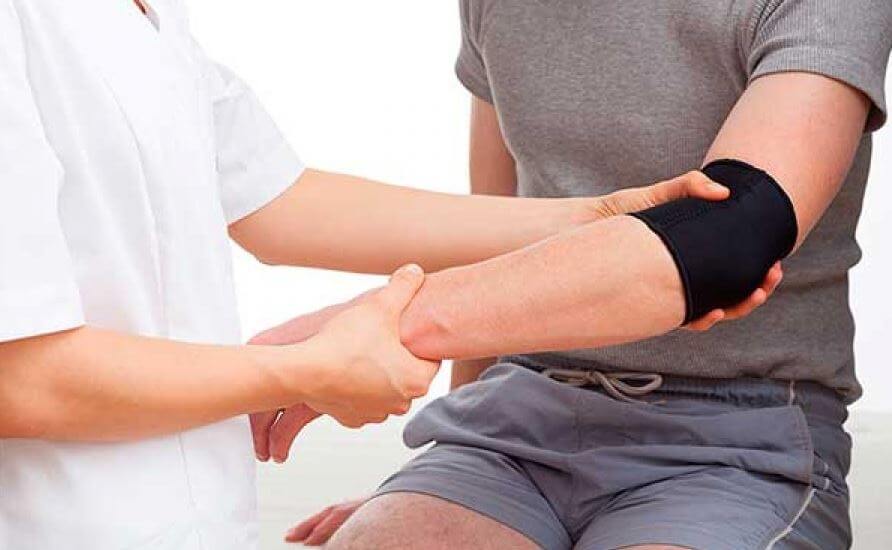Skiing, Common Injuries

Skiing is a winter sport characterized by the use of boots with boards to slide on snow. Skiing may be practiced at a competitive and professional level or at a recreational level. Any of these two options pose injury risks. This is why we’ll inform you about the most common ski injuries and how to prevent them, keep reading!
Skiing is a practice that began in Russia around 6000 B.C. It’s believed that for several years this was the only means of transportation in snow-covered zones. As time passed, and in 1900, skiing evolved and became a sport, especially at a recreational level. However twenty-four years later it was included as a sport in the Winter Olympics in France.
The risks of skiing
Falling while skiing is fairly common. These falls usually happen due to losing your balance, bad posture or the snow’s instability.

Shoulder and collarbone
A dislocated shoulder is frequent in sports, such as skiing. This is because arm movements generate a considerable amount of shoulder rotation. There are two mains reasons why you could dislocate your shoulder:
- While falling you extend your arms: extending your arms is a natural instinct when you fall. However, this increases the risk of an injury since your arm will receive the impact from the fall.
- Problems with your ski pole: a bad movement made with one or both of the ski poles may lead to your arm being in the wrong position.
Collarbone fractures are an injury that’s commonly associated with falls involving arms and shoulders. Therefore, it’s important to learn how to advance and use your ski poles and boots correctly. It’s also essential to wear the correct clothing at all times.
Thumbs
A thumb injury may not seem as important as other injuries. But in fact, your thumbs play a key role in how your hands perform.
This injury may happen while holding the ski pole during a fall, and suddenly pulling the thumb backward. Normally this sprain is not serious, however, if the pain persists after a few days you may need to visit a physiotherapist.
ACL tearing
ACL means anterior cruciate ligament, which is one of the main ligaments in the knee. This ligament is responsible for keeping the knee from overextending or twisting. An ACL tear could be the result of a bad movement wearing the ski boots. An injury such as this requires appropriate care for a good recovery. Never underestimate such a serious injury.

Other injuries
There are other common injuries in skiing too. They may not be so harmful but it’s important that you’re aware of them:
- Meniscus injury: meniscus is the cartilage that allows the knee’s movement.
- Whiplash: this is a neck injury caused by a sudden jerk to the head.
- Back pain from a fall or bad posture.
- Muscular tension due to an inadequate warm-up.
The best way to avoid injuries while skiing is by having professional assistance at hand. If this isn’t possible at least take the advice from someone who is an experienced skier. It’s also important to wear warm clothes and warm up properly before starting. After all, there’s no better sport than a safe sport!
Skiing is a winter sport characterized by the use of boots with boards to slide on snow. Skiing may be practiced at a competitive and professional level or at a recreational level. Any of these two options pose injury risks. This is why we’ll inform you about the most common ski injuries and how to prevent them, keep reading!
Skiing is a practice that began in Russia around 6000 B.C. It’s believed that for several years this was the only means of transportation in snow-covered zones. As time passed, and in 1900, skiing evolved and became a sport, especially at a recreational level. However twenty-four years later it was included as a sport in the Winter Olympics in France.
The risks of skiing
Falling while skiing is fairly common. These falls usually happen due to losing your balance, bad posture or the snow’s instability.

Shoulder and collarbone
A dislocated shoulder is frequent in sports, such as skiing. This is because arm movements generate a considerable amount of shoulder rotation. There are two mains reasons why you could dislocate your shoulder:
- While falling you extend your arms: extending your arms is a natural instinct when you fall. However, this increases the risk of an injury since your arm will receive the impact from the fall.
- Problems with your ski pole: a bad movement made with one or both of the ski poles may lead to your arm being in the wrong position.
Collarbone fractures are an injury that’s commonly associated with falls involving arms and shoulders. Therefore, it’s important to learn how to advance and use your ski poles and boots correctly. It’s also essential to wear the correct clothing at all times.
Thumbs
A thumb injury may not seem as important as other injuries. But in fact, your thumbs play a key role in how your hands perform.
This injury may happen while holding the ski pole during a fall, and suddenly pulling the thumb backward. Normally this sprain is not serious, however, if the pain persists after a few days you may need to visit a physiotherapist.
ACL tearing
ACL means anterior cruciate ligament, which is one of the main ligaments in the knee. This ligament is responsible for keeping the knee from overextending or twisting. An ACL tear could be the result of a bad movement wearing the ski boots. An injury such as this requires appropriate care for a good recovery. Never underestimate such a serious injury.

Other injuries
There are other common injuries in skiing too. They may not be so harmful but it’s important that you’re aware of them:
- Meniscus injury: meniscus is the cartilage that allows the knee’s movement.
- Whiplash: this is a neck injury caused by a sudden jerk to the head.
- Back pain from a fall or bad posture.
- Muscular tension due to an inadequate warm-up.
The best way to avoid injuries while skiing is by having professional assistance at hand. If this isn’t possible at least take the advice from someone who is an experienced skier. It’s also important to wear warm clothes and warm up properly before starting. After all, there’s no better sport than a safe sport!
All cited sources were thoroughly reviewed by our team to ensure their quality, reliability, currency, and validity. The bibliography of this article was considered reliable and of academic or scientific accuracy.
- Avanzi R, Albero A. (2001). Prevención en el esquí. Revista de la Asociación Argentina de Traumatología, 8(1). Disponible en: https://revista.aatd.org.ar/wp-content/uploads/2019/07/2001_Vol-1_n1_6Prevenci%c3%b3n-en-el-Esqu%c3%ad.pdf
- Negrín R. (2012). Prevención de lesiones en esquí. Revista Médica Clínica Las Condes, 23(3), pp.313-317. Disponible en: https://www.sciencedirect.com/science/article/pii/S0716864012703152
- Negrín R, Rubio J, Sepúlveda V, et al. (2021). Lesiones del ligamento cruzado anterior en esquiadores: Conceptos actuales. Revista Chilena de Ortopedia y Traumatología 62(01):066-073. Disponible en: https://www.researchgate.net/publication/352068433_Lesiones_del_ligamento_cruzado_anterior_en_esquiadores_Conceptos_actuales
This text is provided for informational purposes only and does not replace consultation with a professional. If in doubt, consult your specialist.








